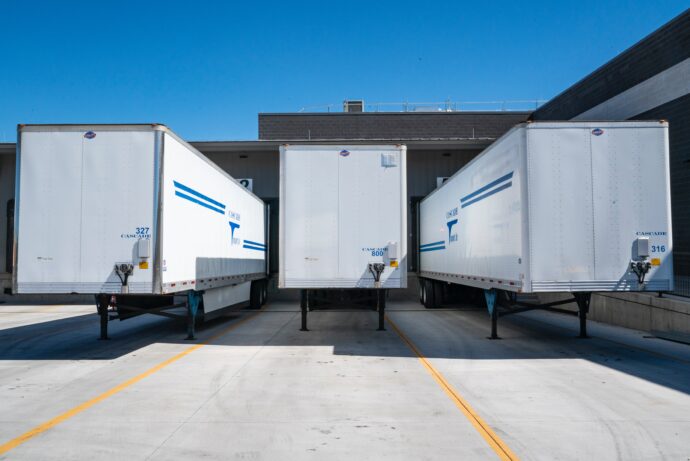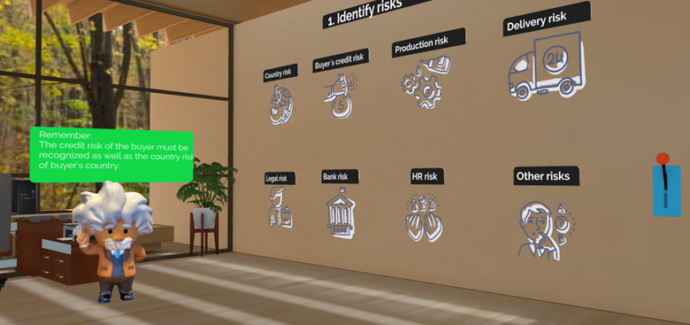According to various studies and barometers, export trade risk management cannot be considered a strength of small and medium-sized Finnish enterprises. The COVID-19 pandemic and the war in Ukraine have naturally contributed to awakening companies to the need for focusing on the careful risk management. The VIVA research, development and innovation project aimed to provide an effective way for companies to create step-by-step a risk-taking policy for their own company. In the VIVA risk-taking policy learning environment, co-created in the virtual reality, companies can reflect on the different stages of the export trade risk management and tailor the process to suit their own businesses.
 Photo: ELEVATE / Pexels
Photo: ELEVATE / Pexels
One of the reasons for the failure of export transactions can be attributed to poor knowledge of risk management solutions. The Finnish exporters, especially SMEs, take alarmingly high risks in export trade, according to the Export Trade Finance Barometer (2019). Another obstacle to the successful risk management is that many companies have a risk-taking policy in mind or in their culture, but not documented and communicated to the whole staff. One in three companies have a written risk-taking policy. (Anttila et al 2019.)
The risks associated with export trade are often identified by the companies, but because those have not been realized, there is a reluctance to prepare for them and to use capital to hedge the company’s receivables. There may also be a belief that the risks will not materialize because they have not materialized so far. Some companies also believe that there is no need to think about risks in advance, but it is only necessary to react when something happens. (Anttila et al 2019.)
Both large and small companies often underestimate the likelihood of a risk materializing and are ill-prepared for a situation where a risk that is considered unlikely materializes. Of course, risk assessment is complicated by the fact that some risks occur extremely rarely, for example only once or twice a century. The likelihood of such risks materializing cannot be predicted by comparison with historical data. (Aspara 2022.)
According to the Finnish Export Credit Agency Finnvera, in many cases export trade risks arise from the foreign customers’ inability or unwillingness to pay, or from the country where the buyer is located (Finnvera 2022). More than 80% of the credit losses are caused by a known customer. Focusing on the assessment of the creditworthiness of the new customers is not enough. (Laitala 2020.)
VIVA guides companies how to create a risk-taking policy
The purpose of the VIVA – Virtual Technologies Boost SME Exports project, funded by the Helsinki–Uusimaa Regional Council, is to provide SMEs with a new way to simulate and practice export trade interactions. The project encounters export trade, modern technologies and continuous learning. Modern technologies refer to Augmented Reality (AR) and Virtual Reality (VR). (Heiskanen & Kuhmonen 2021.)
The VIVA project team’s observations of the daily challenges of the SMEs support the findings of the research that companies’ resources are limited, and staff often need to acquire knowledge, skills and competences by solving acute, concrete problems in small chunks and reflect on the actual issues specifically relevant to their export trade. The VIVA risk-taking policy learning environment is designed to meet these needs.
The goal of the VIVA risk-taking policy learning environment is to guide learners to different sources of information, such as Finnvera’s country risk classification and Acces2Markets database, maintained by the European Commission, which contains a wide range of information on export-related issues, such as customs duties, taxes, rules of origin, formalities and requirements (Finnvera 2022; Access2Markets 2022). The purpose is not to provide ready-made training or solutions, but to encourage businesses to actively seek for up-to-date information. Each company can apply the process and tailor a risk-taking policy that matches to their own export trade, regardless of their size, industry, product or export country.
The VIVA risk-taking policy learning environment was developed in several sprints. The development work was based on the continuous improvement. Workshops were organized for the following purposes: ideating, planning and scripting of the environment, taking 360 pictures and recording audio material. Testing events were also conducted. The learning content was produced in the workshops where the VIVA project’s senior advisor’s knowledge and professional skills were utilized. The content creation was also inspired by the presentations of the keynote speakers from various Nordic banks and the Finnish export credit agency during the VIVA project’s pilot webinars, organized in May – June 2022.
An easy-to-build and easy-to-use WondaVR tool was used for the development of the VIVA risk-taking policy learning environment. The tool is utilized in all the development work of training simulators during the VIVA project. The technical support was provided by 3DBear during the iterations. The project team also gained skills how to use the WondaVR tool.
The structure of the VIVA risk-taking policy learning environment consists of the different phases of the successful risk management: risk identification, risk evaluation, protecting your company against risks, creation of your company’s risk-taking policy, risk monitoring and follow-up. The risks are divided into different categories: country risk, buyer’s credit risk, production risk, delivery risk, legal risk, bank risk, and human resources (HR) risk, as examples of the risks that might occur. Companies are also reminded to consider other potential risks that are relevant to their own export trade.
 Figure 1: The Viva risk-taking policy environment (Viva project 2022).
Figure 1: The Viva risk-taking policy environment (Viva project 2022).
VIVA’s seven steps to the successful export trade risk management
Based on his more than fifty years of Trade Finance experience, the VIVA project’s senior advisor highlights that the main target of the company’s export is to get the full invoice amount as fast and secured as possible to the account of the company (Heino 2022). During the VIVA project, together with companies, examples of elements of successful export trade risk management have been identified and compiled into the following seven steps.
- The export company must have their own risk-taking policy.
- All the possible risks must be taken into the consideration to secure export receivables.
- The risk-taking policy of the company must be communicated to every member of the staff.
- Do not take any risk which is not allowed in the risk-taking policy of the company.
- The credit risk of the buyer must be recognized, as well as the country risk of the buyer’s country.
- The successful usage of the risk-taking policy demands the ongoing follow up of the buyers’ country risk.
- The company is better to lose one good deal than win a bad one.
In the VIVA risk-taking policy learning environment, Einstein’s talking figure reminds companies of the core issues of the successful export trade risk management, which are summarized in the above mentioned seven fundamentals.
 Figure 2: Talking Einstein figure reminds of the core issues of the risk-taking policy (Viva project 2022).
Figure 2: Talking Einstein figure reminds of the core issues of the risk-taking policy (Viva project 2022).
The VIVA risk-taking policy learning environment encourages companies to continuous learning in a rapidly changing global environment. As an area for improvement, it was recognized that the VIVA environment needs to be more interactive and motivate learners in a more varied way. Gamification, as a method to activate learners, will be applied to the VIVA environment during the next iterations.
It is also critical to get as many VIVA companies as possible to test the current version so that it can be further developed according to the feedback. The interactive environment will be part of the final outcome of the VIVA project and openly available to all Finnish exporters.
References:
- Access2Markets. 2022. European commission. Exporting from the EU, importing into the EU – all you need to know. https://trade.ec.europa.eu/access-to-markets/en/home. Retrieved: 15.11.2022.
- Anttila, A., Juuti, K., Laamanen, K., Vivolin, M., Heino, P., Kuhmonen, A., Kyrö, J. & Saarikoski, V. 2019. Tuurillako vientikauppaa käydään? Toimintatutkimus pk-yrityksille riskienhallinnasta ja rahoitusosaamisesta TradeAway-mobiilipelin avulla. https://www.theseus.fi/handle/10024/262350. Retrieved: 1.11.2022.
- Aspara, J. Suomalaisten yritysten riskienhallintaa pitää parantaa. Helsingin Sanomat. Vieraskynä. 24.9.2022.
- The Export Trade Finance Barometer. 2019. Finnvera, Finland Chamber of Commerce and the International Chamber of Commerce (ICC). https://www.finnvera.fi/finnvera/uutishuone/uutiset/vientikaupan-rahoitusbarometri-vientiyritykset-karsivat-suuria-luottotappioita. Retrieved 14.11.2022.
- Finnvera. 2022. Credit risks in export trade. The fewer the risks, the better the night’s sleep. https://www.finnvera.fi/eng/export/credit-risks-in-export-trade. Retrieved: 1.11.2022.
- Finnvera. 2022. Maaluokitukset ja maaluokituskartta. https://www.finnvera.fi/vienti/vientitakuutoiminta/maaluokitukset. Retrieved: 1.11.2022
- Heino, P. 2022. The VIVA project’s Internal Workshop at Laurea Hyvinkää Campus. 20.9.2022.
- Heiskanen, M. & Kuhmonen, A. 2021. Tietoja. https://vivaboost.fi/tietoja/. Retrieved: 26.10.2022.
- Laitala, J. 2020. Tarkasta, riittääkö asiakkaallasi rahaa. Atradius. 2020. https://atradius.fi/article/tarkasta,-riitt%C3%A4%C3%A4k%C3%B6-asiakkaallasi-rahaa-082020.html. Retrieved: 1.11.2022.